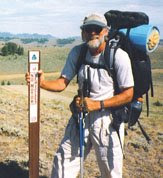 The Amazon Outdoor Store
The Amazon Outdoor Storeby stephen gorman
trekking tropical trails
Just beyond the northern boundary of Everglades National Park lies a vast, primordial swamp of dwarf pond cypresses and slash pine islands, of hardwood hammocks and wet prairies, of sawgrass marshes and mangrove forests. Here, in Big Cypress National Preserve, 700-year-old great cypresses somehow escaped the loggers' blades; blooming air plants perch on tropical hardwoods like flocks of strange birds at rest; and alligators slip into the dark pools of backwater sloughs.
These sights await the adventurous hikers who set out on the Florida Trail--a national scenic trail that will eventually stretch 1,300 miles to Gulf Islands National Seashore, on the western edge of Florida. Thirty-eight miles of the trail are in the preserve, and hiking this singular footpath is a chance to immerse yourself in the splendor of the tropical wilderness.
Once home to the Seminole Indians, whose reservation lies just to the north, Big Cypress National Preserve acts as a buffer between the fragile ecosystem of Everglades National Park and the land development sweeping unchecked across South Florida. But the preserve, which was established in 1974, not only protects the park from human sprawl, it provides the Everglades with its lifeblood. With a gradient of a scant two inches per mile all the way to the Gulf of Mexico, the vast sheet of water spreading through the preserve releases a gradual flow of nutrient-rich fresh water into the national park.
Today both ecologists and recreationists acclaim Big Cypress as a natural gem in its own right. The preserve's vast, swampy reaches are critical habitat for a rich and diverse wildlife community that includes alligators, black bears, white-tailed deer, and West Indian manatees. The endangered wood stork, the snail kite, and the red-cockaded woodpecker also find sanctuary in these 729,000 protected acres. Several Florida panthers, which now number fewer than 50, prowl behind the preserve's veil of Spanish moss and saw palmettos.
After a long day on the trail, you set up camp among the live oaks on a small hump of land, change into dry footwear, and relax. Stars glitter through the tangled branches overhead. Somewhere nearby, a bobcat's scream tears through the night, and you sit bolt upright. But when your heartbeat returns to normal, you smile, flushed with exhilaration--the lifting of the spirit that is the true gift of this wild and ancient place.
wade in
Hiking in Big Cypress National Preserve means getting your feet wet, so be sure to carry an extra pair of shoes. During the subtropical winter--roughly November to April--the weather is generally clear and the temperatures moderate. Even so, the winter sun can be intense and the air buggy, making sunscreen, a hat, and insect repellent necessary. Potable water is scarce, so consider packing a water filter, and even toting water with you during the bone-dry spring. Big Cypress is located just north of Everglades National Park, 40 miles west of Miami and 30 miles east of Naples. For more information, consult Big Cypress National Preserve (941-695-4111, ext. 0; www.nps.gov/bicy), which dispenses the required backcountry permits, or the Florida Trail Association (800-343-1882; www.florida-trail.org).


